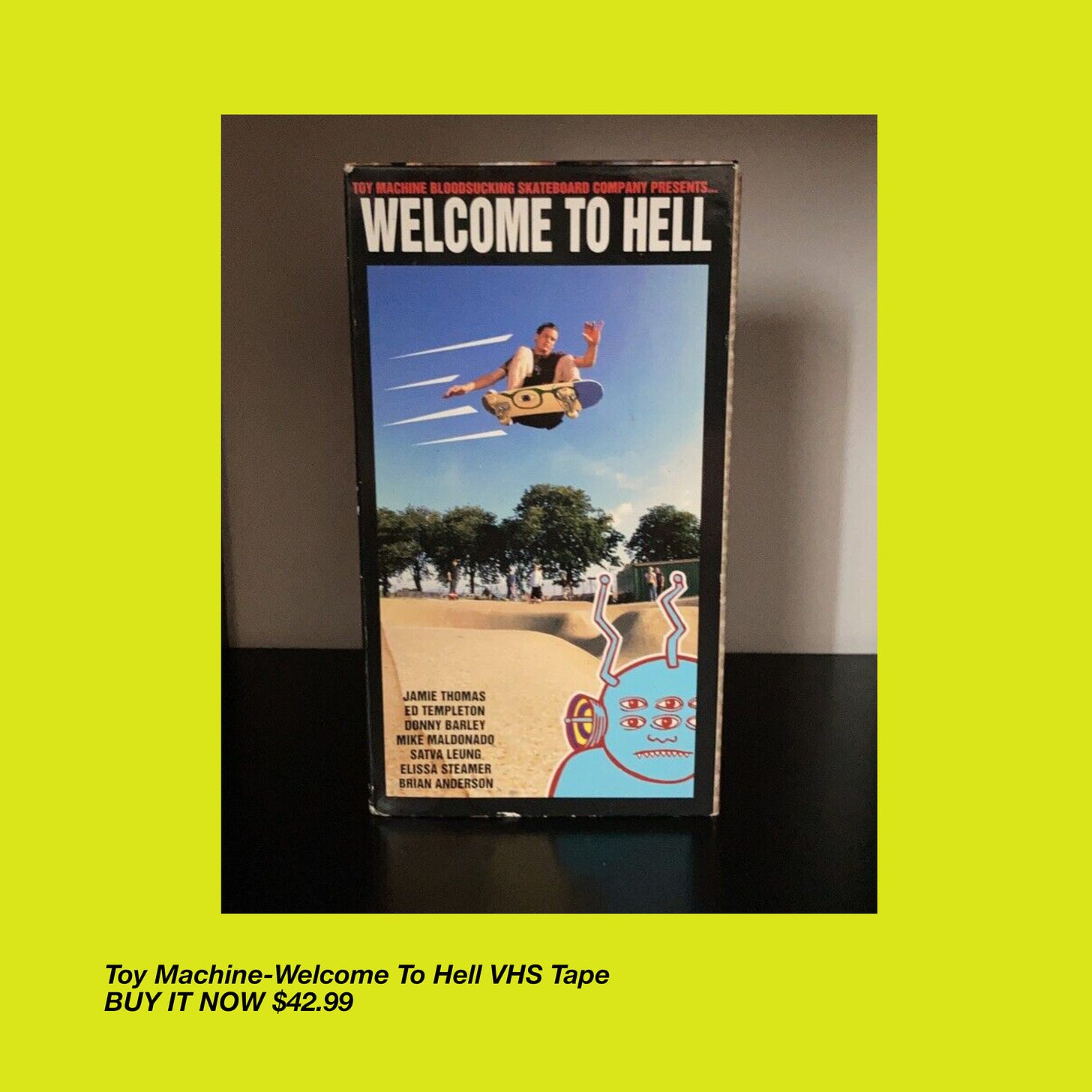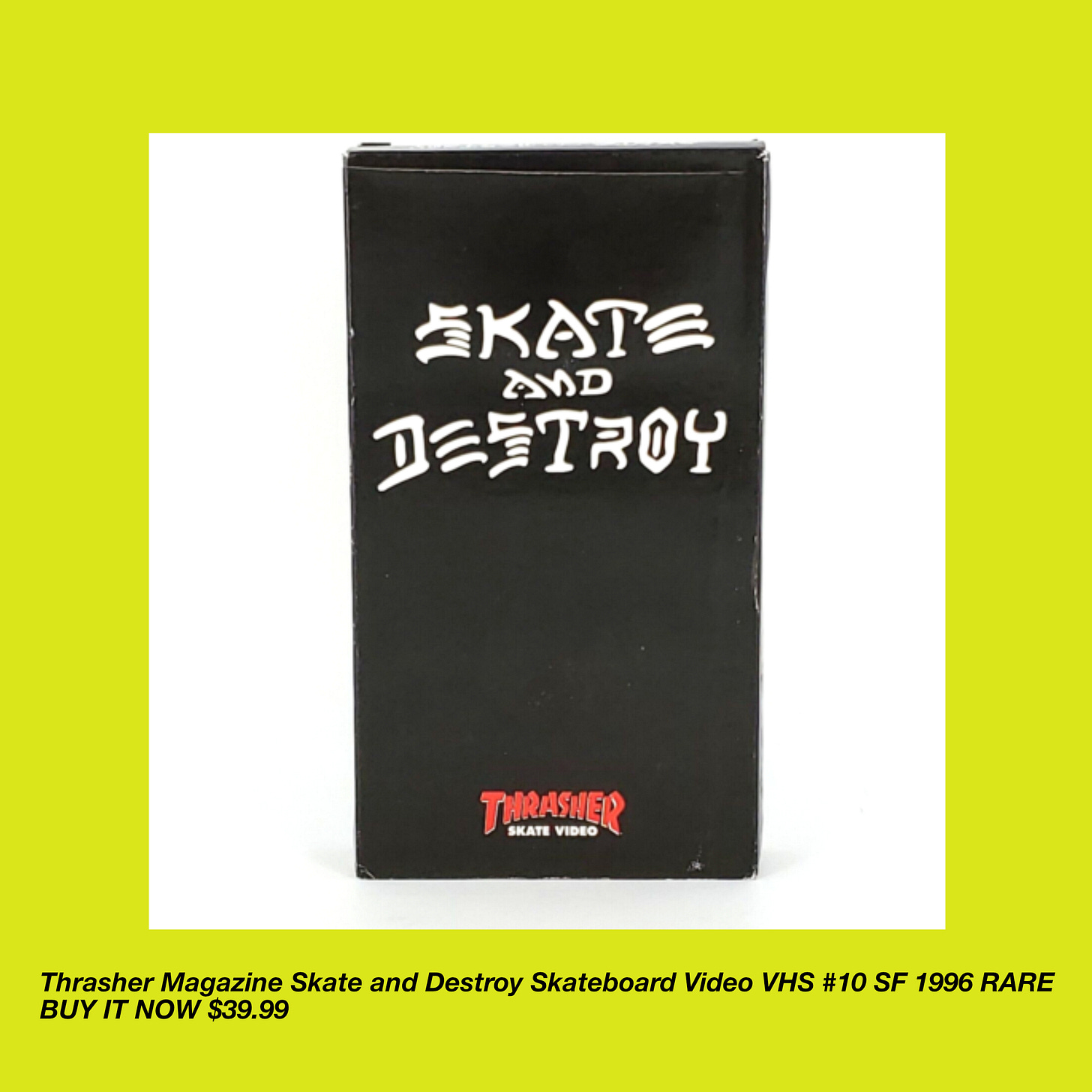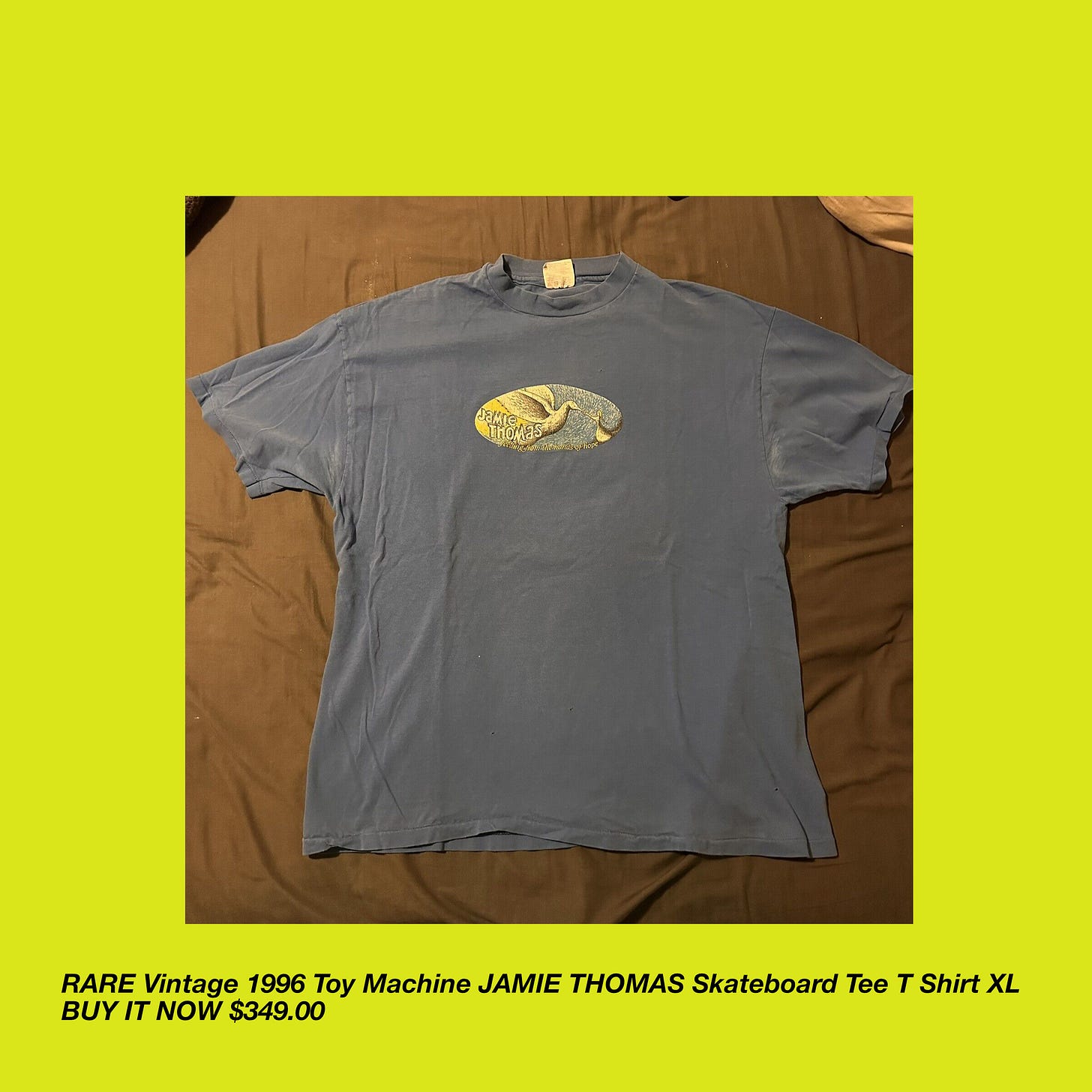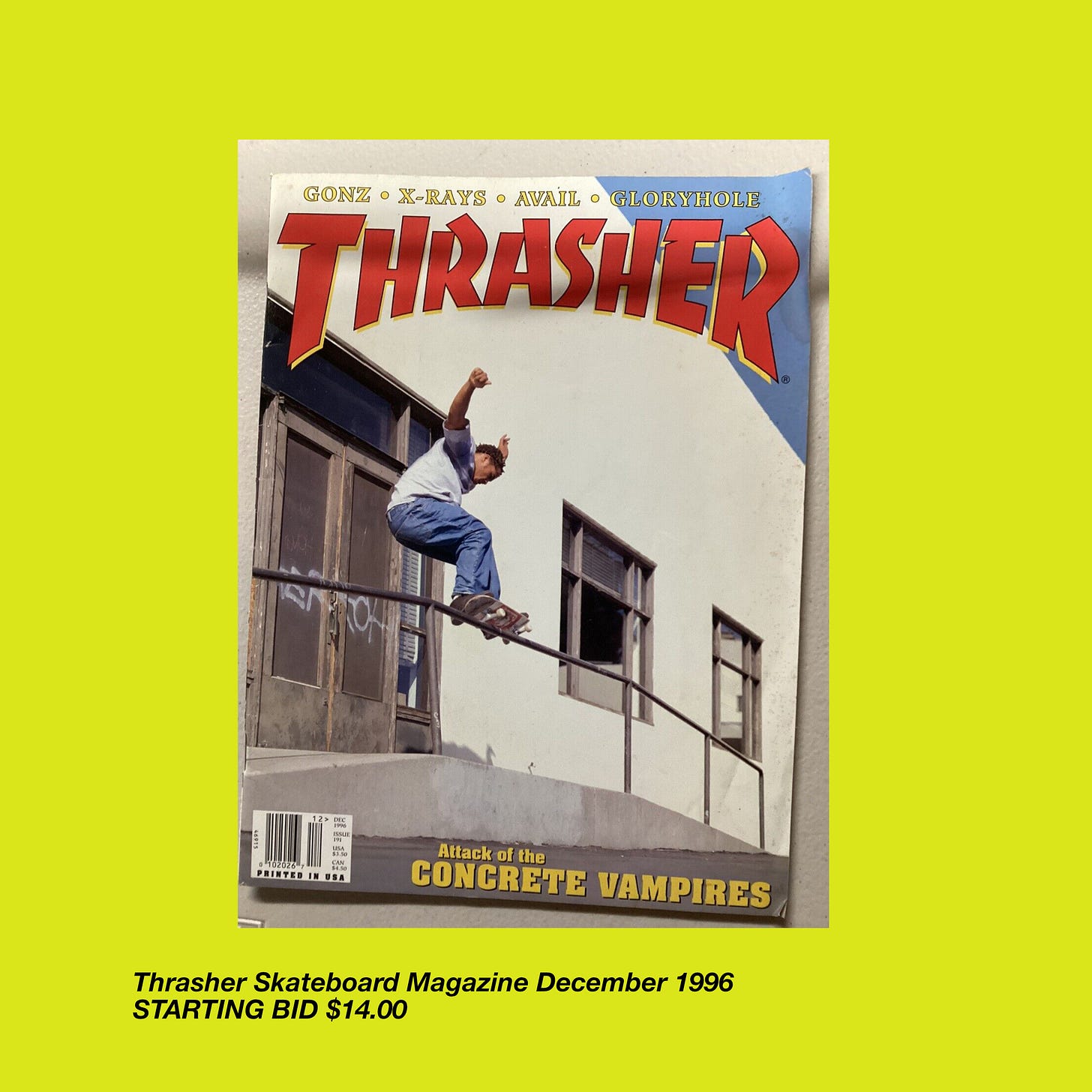THE BEST 1996 SKATE VIDEOS ON EBAY & MORE
If The Secret Tape Doesn't Have Them, You're Kinda Screwed
Back in 2016, I wrote a two-part piece about the best skate videos from the year 1996 for SML Talk. The link is dead but I still contend that 1996 was a massively important year in skate videography.
You’ve probably seen Ted Barrow’s new Thrasher Magazine series “This Old Ledge.” Along with his extensive spot histories, Ted recently wrote about the year 1996 for Free Magazine.
Here’s a blurb from Ted’s piece:
Let me explain: in 1996, the three best skate videos of that year — arguably the decade — were Toy Machine’s Welcome to Hell, World Industries’ Trilogy, and Girl’s Mouse. Dan Wolfe released Eastern Exposure 3, 411 #19, and Thrasher’s Skate & Destroy were also released that same year. In the US, it was a great year for skateboarding, perhaps the best year for US-released videos featuring American pros ever, the height of the nineties. The inevitable fusion of east coast plazas and west coast schoolyards all forged this powerful and stylish form of street skating, often set to absolute bangers in hip- hop.
I read it as you should too and then I had a real lightbulb moment. Two of them!
I should revisit that old piece I wrote to see if it sucks.
I should see if I can find some of those videos on eBay because I’ve been doing that lately.
Ted’s piece reinforced my conviction that 1996 was a heavy year and even better, it’s 2023 and 1996 is relevant. You could say it’s even #trending. There’s even a 1996-inspired shoe coming out this week from Tony Ferguson and RONE.
So, we have writing, we have shoes, I happen to have some text, and you can buy things on eBay—things from 1996. Perfect. Well, not perfect because I have to go back and revisit something I wrote a while back which usually kind of sucks, but as it turns out, the words aren’t dogshit.
The result of this 1996 stew?
Some auctions and some old writing that I edited a bit, meaning I kept the spirit but tweaked a few things.
OLD WRITING AHEAD CIRCA 2016
*This means some of this stuff is out of date or wrong or whatever, so don’t “well, actually” me please. I mean, you can but this online writing shit is stressful so I’d appreciate it if you didn’t.
(Originally published on SMLTalk.com)
The progression from 1970 to 1990 in skateboarding might only be paralleled by leaps made in the home video game industry. From bouncing a gray pixel between two lines in Pong to Super NES, that twenty-year chunk in skating is equally dramatic. Watch Dogtown & Z-Boys (the documentary not the motion picture) and then peep Ed Templeton’s part from New Deal’s Useless Wooden Toys, Frankie Hill’s stunt work in Powell Peralta’s Propaganda, or Ray Barbee’s grace from the same video. If you’re still curious and have about two hours to spare, go right to this video of raw footage by Tony Roberts featuring Eric Britton, Colby Carter, Ocean Howell, and Markus Wyndham pushing each other to new tricks, some of which would later appear in Santa Cruz’s Risk It video.
Skateboarding had gone from homemade banana boards and sidewalk surfing to Mr. Hill jumping over a grassy knoll and people starting to flip into grinds and slides—real future shit. The entire language of skateboarding had changed in that time period and what was possible was changing from video to video by the time we hit the ‘90s.
I’m not saying that folks who were around for sessions in the ‘70s weren’t feeling the same way as they saw skateboarding move from grooving and carving to aerial maneuvers, but having it documented on video and later, sent to your mailbox via 411VM, along with the advancement of equipment not only pushed technicality, but pushed it to a global audience. Video transformed skateboarding. This is a fact and 1996 was a year in skateboarding that illustrates how far things had come and where they were headed.
Running through the videos released in the year 1996, it’s apparent that there’s a massive amount of predictive output that was released on VHS cassette, much of it very indicative of what you’re watching on your computer/phone screen in 2016. (told you this was old text)
So, rather than look back at this like some fallen High School sports stars, depressingly recalling their salad days over domestic beer and hot wings, let’s recount a truly incredible year in skateboarding video history. *2023 addition: Let’s do this by reading about these videos and linking to eBay where you can buy them.
1996, the year of Mad Cow Disease, the Spice Girls, Independence Day, and the first Major League Soccer match, as well as a bunch of shit in skateboarding that is truly incredible... and the year Jerry Fowler officially moved to Boston.
Toy Machine - Welcome to Hell
Brian Anderson, Donny Barley, Ed Templeton, Elissa Steamer, Jamie Thomas, Mike Maldonado, Satva Leung
Did you ever think that 20 years after its release, a bespoke NYC magazine would leverage Satva Leung ollieing over something to celebrate a collaborative Toy Machine capsule collection? Me either. More importantly, this video was the world’s introduction to Thomas Vision®, the signature style of filming really big shit that set in motion an entire battalion of folks who could do really big things. Huge things. Things that created an entire genre of skateboarding that Frankie Hill and Pat Duffy influenced greatly.
Anecdotally, few skate videos premiered at all in the mid-’90s because few videos were released then. An East Coast premiere (where I lived) was extremely rare, but this video was shown in some theatre outside of Boston—I believe by Coliseum Skate Shop. I recall nothing about this event, other than being awestruck and that it was the first true non-contest or demo skate event I attended. Seriously, there weren’t even that many art shows back then. Years later I’d move to New York City and amble upon skate events daily. (That’s kind of true.)
Of course, Toy Machine has soldiered on and is celebrating 30 years in the game with some reissue decks (yup, I added this), Ed is making tons of art and photos and books, Jamie Thomas is still Jamie Thomas, but what’s most noteworthy is Elissa Steamer’s breakthrough part—a landmark in skateboarding history that you should watch. I made it easy for you.
Girl - Mouse
Ben Sanchez, Chico Brenes, Daniel Castillo, Eric Koston, Gabriel Rodriguez (RIP), Gino Iannucci, Guy Mariano, Jeron Wilson, Jovontae Turner, Keenan Milton (RIP), Mike Carroll, Mike York, Richard Mulder, Rick Howard, Rudy Johnson, Sean Sheffey, Shamil Randle, Tim Gavin, Tony Ferguson
I mean, where do you start with this one? The skits, the footage, the music supervision, the guest company section? Even though it wasn’t entirely filmed in Los Angeles, Mouse feels LA. This entire piece could be about Mouse but let’s just focus on what most of us think of when we hear the name.
While Guy Mariano’s (first) comeback part in Mouse has become such a “Top Five Parts” staple that it, along with Gonz or J-Lee from Video Days should be automatics, like the R, S, T, N, L, and E in Wheel of Fortune, it’s important to note why this part was so significant.
There are several factors, but the two most salient points are as follows: relatability and unbelievability. Mariano was neither a rail skater nor a gap skater, but he was a pioneer in bringing technical prowess to both. He also destroyed ledges. And he looked very cool doing all of it. You can see him push. He looks like a different human throughout the part, implying some evolution. The music is perfect—edited to his footage with a rare finesse and synergy where the sounds of the music seem to be flowing throughout the footage, even though there’s no music.
Guy originally wanted to skate to "Hand of Doom” by Black Sabbath. I’m sure that would have been cool but the choice of Herbie Hancock’s “Watermelon Man” is so out-of-the-box and unique that it will forever be “the Guy Mariano song” to many.
Years ago as an exercise, I edited Guy’s Mouse part to “Halleluwah” by Can. I think I was curious to see if the part would be as amazing if it were set to one of my favorite bands. You can decide.
Here it is.
Guy wore several styles and brands of shoes in his part. Guy Fucking Mariano didn’t have a steady shoe sponsor back then, but he did ride for Converse for 30 seconds. He skated so cleanly both ways, that it made you forget his natural stance until you realized later which tricks were switch, adding value to the viewing.
Was the random switch slappy grind on the round bar a sneak diss to Philadelphia, an extension of his virtuosity and mastery, or homage?
We probably won’t know, nor does it matter. Mouse stands as one of the most significant skateboarding videos of all time, so much so, that even bitter East Coasters, who often shunned technicality for rawness agreed.
*Please note the video in this auction is missing the clear cover and printed title card.
Eastern Exposure 3: Underachievers and Zero
Donny Barley, Jahmal Williams, Jerry Fisher, Fred Gall, Keith Hufnagel, Matt Reason, Mike Maldonado, Reese Forbes, Ricky Oyola, Tim O'Connor, Quim Cardona, Sergei Trudnowski, and so many NYC skaters… seriously, too many to mention.
What Dan Wolfe’s videos did for East Coast skateboarding is as important as Dischord’s contribution to music. Dischord’s ethos has been and always will be that they exclusively release music independently by Washington, D.C. artists, with a few minor exceptions. Wolfe’s videos also had some West Coast “artists,” but the core of Donny Barley, Jahmal Williams, Ricky Oyola, and Resse Forbes is his Four Old 7”s On a 12”.
Translation: influential, iconic, legendary, and packaged together for maximum impact.
Oyola once wanted to release a Zoo York graphic featuring a US map, sans California and this unreleased idea encapsulates the spirit of Underachievers. It wasn’t as much of a “fuck you,” as it was a “fuck yeah,” and once you were absolutely pummelled by Oyola’s footage, set to Metallica’s “Damage Inc.” change was in motion.
Polejams, bulkheads, lines weaving through traffic, Love Park, Pulaski, Copley Square, and skating’s most iconic non-spot, the Astor Cube, the Northeast (and a lot of Florida) had arrived to the masses.
One thing to note that often gets overlooked was that Mr. Barley put out two crushing parts that year, both high-profile and indie, with Toy Machine and EE3, proving to be a great move in cross-promotion, amplifying EE3 and adding validity to the movement. We should also mention Josh Stewart, he’s effectively taken Wolfe’s lessons and learnings and created an entirely new franchise with his unmistakable eye and taste, expanding it into Theories of Atlantis, as well as leaving us with the gorgeously gritty Static series. He also filmed some clips for Welcome To Hell, thank you to Josh and everyone involved.
*This is not a good price.
World Industries / Blind / 101 - Trilogy
Clyde Singleton, Daewon Song, Enrique Lorenzo, Gideon Choi, Gino Iannucci, Jason Dill, Josh Kasper, Kareem Campbell, Lavar McBride, Marcus McBride, Maurice Key, Ronnie Creager, Sam Devlin, Shiloh Greathouse, Eric Pupecki, Fabian Alomar, Joey Suriel, Billy Valdez, Javier Nunez
Starting with the 101 section it’s worth pointing out something that hasn’t been discussed about Gino’s footage here: this is barely a song, yet it completely works. It’s erratic, often grating, and slightly unnerving, yet it contrasts the part perfectly, giving way to a steady beat, before abruptly winding down, giving your brain a few seconds to process things, before segueing into the superbly acted Menace skit. Funny enough, Fabian Alomar isn’t in said skit but he’s now a real actor. The entire video is fantastic but the 101 section is 8 minutes (almost) of perfection.
As a bookend to the advancement of LA-Tech to Mouse, Trilogy fills out exactly what the elite side of California city skateboarding was in 1996. Sure, San Diego was great and all, but this is what translated to the globe at large, not only because there was a style of skater in these videos that would appeal to almost any person, but in the sheer star quality all involved had. Menace was almost a bizarro Zoo York, and that’s a good thing, right?
Let’s not forget that even though they commingled, the World and Girl camps were pitted as enemies in the press, mimicking the Lakers and Kings rivalry… or something. Most importantly, Trilogy and Mouse pretty much set the pace for Primitive and whatever ledge trickery is happening each Sunday at J-Kwon.
Now, an open plea to Socrates Leal to digitize all the unseen footage he’s sitting on. Please Soc?
F.T.C. Penal Code 100A
Bobby Puleo, Keith Hufnagel (RIP), Max Schaaf, Mike Carroll, Rick Howard, Scott Johnston, Mike York, Joey Alvarez, Markus Brown, Peter Bici, Mike “Hitman” Hernandez, Fabian Alomar, Chico Brenes, Karl Watson, Lee Smith, Shamil Randle, Jesse Macmillan, Spencer Fujimoto, Kenny Kirk, Jeff Pang, Jovantae Turner, Nick Tershay, Drake Jones, Ben Sanchez, Richard Mulder, Chris Keefe, Jones Keefe, Lavar McBride, Marcus McBride, Guy Mariano, Eric Pupecki, Jeron Wilson, Keenan Milton (RIP), Eric Koston, Rudy Johnson, Weston Correa, Matt Willigan, Greg Hunt, Quim Cardona, Lamont Macintosh, Pepe Martinez (RIP), Ben Liversedge, Robbie Gangemi, Rob Carylon, Phil Shao(RIP)
Credit Aaron Meza for having the balls to edit this one sans-skate sounds, allowing his expert soundtrack choices to shine through, making Penal Code 100A feel very warm and analog.
*Editor’s note: Meza has since mentioned that the editing choice was simply a happy accident.
Even for the time, there was something cozy and retro feeling about the video, even though the actual skating was supremely advanced and current. Let’s also note the most important thing about this F.T.C. San Francisco Skate Shop Video, which was pointed out to me by a friend in a conversation recently: It’s the greatest East Coast video made on the West Coast and one of the greatest shop videos as well.
With contributions by R.B. Umali, you got the “family” section mostly filmed in NYC featuring… well… a lot of very cool New Yorkers skating very well. The video starts with Bobby Puleo and arguably features Huf’s greatest skateboarding part, and yes, Scott Johnston is not from California either. This video is a capsule of time that is so significant that it has subconsciously and also consciously informed the future.
The song choices, the backdrops, and the integration of bi-coastal talent into one concerted skateboarding effort show that we can all get along after all and that Puleo part is an absolute monster of an opener, plus you get a shared Rick and Mike part. Come on.
OR BUY THE REAL-ASS VHS FROM THE SECRET TAPE FOR $69.00
*Every list needs a controversial choice and this certainly was at the time of publishing. Also, including a DVD now is controversial but I can’t find a VHS on eBay and I don’t want to sell my copy—that feels too entrepreneurial. Instead, I linked to The Secret Tape where you should be buying old shit anyway.
*NOTE #2: Free Magazine (the link is to the relevant part, not Free) did an extensive Benny Fairfax interview where he spoke about his dealings with Ethan Fowler—truly gross behavior by Ethan and it felt important to note this when revisiting the text.
Stereo Tincan Folklore
Carl Shipman, Chris Pastras, Ethan Fowler, Greg Hunt, Jason Lee, Matt Rodriguez, Mike Frazier
The lesser namechecked video of the brief Stereo franchise, but in dissecting it, perhaps the more low-key influential. Sprawling mundane yet purposeful montages, a relatively twee soundtrack, grounded by post-rock legends Tortoise, UK footage, and jarring edits, much akin to Memory Screen.
In a way, Tincan Folklore shares more DNA with the beloved, golden-era Alien/Habitat films of the late-’90s and early 2000s than Time Code would a year later. It’s the right balance of slightly askew and rightly aligned, without dipping into “art for art’s skate” territory and employing enough noteworthy skateboarding.
In the wake of the jazzy A Visual Sound, Stereo found its roster a bit lighter but still anchored by the youthful verve of Ethan Fowler, alongside the speed and style of Matt Rodriguez and Carl Shipman. Shipman in particular puts in a somewhat left-field part in the wake of his Stereo debut, opting for a very lurky, murky, lo-fi offering, showcasing more abstract, environmental skating, yet still finessed. I mean, he does a pole jam and skates a lot of transition—it’s a bit of a departure, but also, as the part bashes away to the fractured beat, there’s something quite Palace-ian about this section, kind of.
With the true ender in Fowler’s part—Jason Lee’s “part” was a bit of a cruel joke—the “new” Stereo vibe is fully revealed. Fowler stomps and slashes around to a punky, garage rendition of “If I Only Had a Brain.” It’s ramshackle and haphazard—the anthesis of the top shelf scotch smoothness of A Visual Sound.
Despite it being a rougher delivery, we can draw the conclusion that you need to learn how to draw before you can color outside the lines, otherwise, it’s going to just look like a pile of scribbles. Tincan Folklore is not a pile of scribbles and it’s worth a rewatch.
Lastly, I am a Greg Hunt skateboarding fan and nothing puts me at ease mentally than watching him craft lines, popping in and out of tricks unconventionally, while Tortoise’s “Tin Cans and Twine,” throbs along during the mid-point of his part.
I don’t know how this fits contextually in 2016, but you should probably just watch it again or for the first time if you’re so lucky. Hunt’s part is a beautiful paradox, with his smooth, speedy lines, soundtracked by Tortoise’s melancholy post-rock—a minimalist masterpiece, for those who appreciate the strength of the line, much like Franz Kline’s abstract paintings, and I say that in the least pretentious way possible.
Honorable Mentions:
Mad Circle - Let the Horns Blow
Think - Damage
New Deal - Promo 96
Planet Earth - Silver
Big Brother - Shit
Thrasher, 411VM, and Transworld’s video output in 1996.
You can definitely buy the video but I suggest enjoying 7 minutes of prime Boston skateboarding from 1996-ish.
Thrasher Magazine September 1996, Cover: Jonathan Bohannon. Artwork By: Gomez Bueno
I don’t recall Thrasher making this shirt and it lacks a woven Thrasher Tag. The photos show that this tee was made on a Gildan Softstyle blank which is a much newer shirt option. I’m not sure when Thrasher switched over to the woven labels but most of their official merch from the ‘90s-’00s was printed on Hanes Beefy-Ts, Anvil, and Oneita blanks, however, they often leave the factor tags below the fancy new woven ones, so it’s possible the owner of this removed the OG tag and this is a newer tee from the past 10-ish years. I doubt that though, and it’s likely someone made this with some DTG service but it’s still a 1996-centric T-shirt that’s pretty cool and cheap.
This David’s Skate Park tee appears to be legit/from 1996-ish and isn’t expensive but also, it’s not that exciting. It has a date though and dates on shirts are neat and this particular date is historically significant.
Like anything, if you’re willing to pay more, you’ll get more and this auction for a Jamie Thomas “Feeding From the Hands of Hope” T-Shirt is both rare and I can say with confidence, it’s legit.
Here’s the board graphic from 1996, right before Mr. Thomas left to start Zero.
But it’s really expensive and we discussed in the last Artless the whole thing about wearing people’s names on shirts that aren’t a well-known sports figure… at least well known to civilians. It can be weird.
This could be an affordable piece of 1996 history and it’s an incredible shot of Sean Sheffey on the cover.
Price. Graphic. Charming Wear. Relevance.
Thank you for reading this week’s newsletter.




















Guess I have to be “that guy” but doesn’t Ricky skate to damage inc?